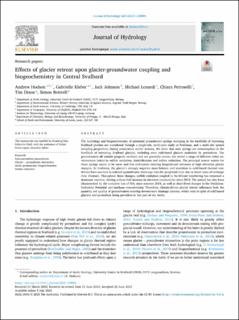| dc.contributor.author | Hodson, Andrew | |
| dc.contributor.author | Kleber, Gabrielle Emma | |
| dc.contributor.author | Johnson, Jack | |
| dc.contributor.author | Lonardi, Michael | |
| dc.contributor.author | Petroselli, Chiara | |
| dc.contributor.author | Dixon, Tim | |
| dc.contributor.author | Bottrell, Simon | |
| dc.date.accessioned | 2023-11-10T12:19:46Z | |
| dc.date.available | 2023-11-10T12:19:46Z | |
| dc.date.created | 2023-09-05T11:02:05Z | |
| dc.date.issued | 2023 | |
| dc.identifier.citation | Journal of Hydrology. 2023, 624 . | en_US |
| dc.identifier.issn | 0022-1694 | |
| dc.identifier.uri | https://hdl.handle.net/11250/3101890 | |
| dc.description.abstract | The hydrology and biogeochemistry of perennial groundwater springs emerging in the forefields of retreating Svalbard glaciers are considered through a single-site, multi-year study at Foxfonna, and a multi-site spatial sampling programme during consecutive winter seasons. We show that such springs are commonplace in the forefields of retreating Svalbard glaciers, including even cold-based glaciers underlain by permafrost. The groundwaters all contain geogenic methane and are generally anoxic, but reveal a range of different redox environments linked to sulfide oxidation, denitrification and sulfate reduction. The principal source waters for these springs seems to be snow and firn meltwaters entering bergschrund crevasses at high elevation glacier margins. At Foxfonna, the glacier’s strongly negative mass balance and transition to cold-based thermal conditions have resulted in reduced groundwater discharge into the proglacial river due to lower rates of recharge (less dilution). Throughout these changes, sulfide oxidation coupled to Na-Silicate weathering has remained a dominant reaction, driving a three-fold increase in electrical conductivity since 2010. The period has also been characterised by the complete loss of NO3– since summer 2018, as well as short-lived changes in the Oxidation-Reduction Potential and methane concentration. Therefore, climate-driven glacial retreat influences both the quantity and quality of groundwaters entering downstream drainage systems, which exist in spite of cold-based glaciers and permafrost being prevalent in this part of the Arctic. | en_US |
| dc.language.iso | eng | en_US |
| dc.publisher | Elsevier | en_US |
| dc.rights | Navngivelse 4.0 Internasjonal | * |
| dc.rights.uri | http://creativecommons.org/licenses/by/4.0/deed.no | * |
| dc.title | Effects of glacier retreat upon glacier-groundwater coupling and biogeochemistry in Central Svalbard | en_US |
| dc.type | Peer reviewed | en_US |
| dc.type | Journal article | en_US |
| dc.description.version | publishedVersion | en_US |
| dc.rights.holder | © 2023 The Author(s) | en_US |
| dc.source.pagenumber | 11 | en_US |
| dc.source.volume | 624 | en_US |
| dc.source.journal | Journal of Hydrology | en_US |
| dc.identifier.doi | 10.1016/j.jhydrol.2023.129894 | |
| dc.identifier.cristin | 2172433 | |
| dc.relation.project | Norges forskningsråd: 294764 | en_US |
| dc.source.articlenumber | 129894 | en_US |
| cristin.ispublished | true | |
| cristin.fulltext | original | |
| cristin.qualitycode | 2 | |

